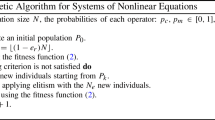Abstract
A novel method for solving ordinary and partial differential equations, based on grammatical evolution is presented. The method forms generations of trial solutions expressed in an analytical closed form. Several examples are worked out and in most cases the exact solution is recovered. When the solution cannot be expressed in a closed analytical form then our method produces an approximation with a controlled level of accuracy. We report results on several problems to illustrate the potential of this approach.
Similar content being viewed by others
References
J. D. Lambert, Numerical methods for Ordinary Differential Systems: The Initial Value Problem, John Wiley & Sons: Chichester, England, 1991.
J. R. Koza, Genetic Programming: On the Programming of Computer by Means of Natural Selection. MIT Press: Cambridge, MA, 1992.
J. Nieminen and J. Yliluoma, “Function Parser for C++, v2.7”, available from http://www.students.tut.fi/~warp/FunctionParser/.
G. E. Fasshauer, “Solving differential equations with radial basis functions: Multilevel methods and smoothing,” Advances in Computational Mathematics, vol. 11, nos. 2–3, pp. 139–159, 1999.
I. Lagaris, A. Likas, and D. I. Fotiadis, “Artificial neural networks for solving ordinary and partial differential equations,” IEEE Transactions on Neural Networks, vol. 9, no. 5, pp. 987–1000, 1998.
G. Burgess, “Finding approximate analytic solutions to differential equations using genetic programming,” Surveillance Systems Division, Electronics and Surveillance Research Laboratory, Department of Defense, Australia, 1999.
H. Cao, L. Kang, Y. Chen, and J. Yu, Evolutionary modeling of systems of ordinary differential equations with genetic programming, Genetic Programming and Evolvable Machines, vol. 1, pp. 309–337, 2000.
H. Iba and E. Sakamoto,: “Inference of differential equation models by genetic programming,” Proceedings of the Genetic and Evolutionary Computation Conference (GECCO 2002), 2002, pp. 788–795.
M. O’ Neill, Automatic Programming in an Arbitrary Language: Evolving Programs with Grammatical Evolution. PhD thesis, University Of Limerick, Ireland, August 2001.
C. Ryan, J. J. Collins, and M. O’ Neill, Evolving programs for an arbitrary language, in Proceedings of the First European Workshop on Genetic Programming, volume 1391 of LNCS, W. Banzhaf, Ri. Poli, M. Schoenauer, and T. C. Fogarty, (eds.), Springer-Verlag, pp. 83–95, Paris, 14–15 April 1998.
M. O’Neill and C. Ryan, Grammatical Evolution: Evolutionary Automatic Programming in a Arbitrary Language, volume 4 of Genetic programming. Kluwer Academic Publishers, 2003.
C. Ryan, M. O’Neill, and J. J. Collins, “Grammatical evolution: Solving trigonometric identities,” in Proceedings of Mendel 1998: 4th International Mendel Conference on Genetic Algorithms, Optimization Problems, Fuzzy Logic, Neural Networks, Rough Sets., Brno, Czech Republic, June 24–26 1998. Technical University of Brno, Faculty of Mechanical Engineering, pp. 111–119.
M. O’Neill and C. Ryan, “Grammatical evolution,” IEEE Trans. Evolutionary Computation, vol. 5, pp. 349–358, 2001.
D. E. Goldberg, Genetic algorithms in search, Optimization and Machine Learning, Addison Wesley, 1989.
J. J. Collins and C. Ryan, “Automatic generation of robot behaviors using grammatical evolution,” in Proc. of AROB 2000, the Fifth International Symposium on Artificial Life and Robotics.
M. O’Neill, J. J. Collins, and C. Ryan, “Automatic generation of caching algorithms,” in Evolutionary Algorithms in Engineering and Computer Science, Kaisa Miettinen, Marko M. Mkel, Pekka Neittaanmki, and Jacques Periaux (eds.), Jyvskyl, Finland, 30 May–3 June 1999, John Wiley & Sons, pp. 127–134, 1999.
A. Brabazon and M. O’Neill, “A grammar model for foreign-exchange trading,” in Proceedings of the International conference on Artificial Intelligence, volume II, H. R. Arabnia et al. (eds.), CSREA Press, 23–26 June 2003, pp. 492–498, 2003.
P. Cusdin and J. D. Muller, “Automatic differentiation and sensitivity analysis methods for CFD,” QUB School of Aeronautical Engineering, 2003.
O. Stauning, “Flexible automatic differentiation using templates and operator overloading in C++,” Talk presented at the Automatic Differentiation Workshop at Shrivenham Campus, Cranfield University, June 6, 2003.
C. Bischof, A. Carle, G. Corliss, and A. Griewank, “ADIFOR - generating derivative codes from fortran programs,” Scientific Programming, no. 1, pp. 1–29, 1992.
A. Griewank, “On automatic differentiation” in Mathematical programming: Recent Developments and Applications, M. Iri and K. Tanabe (eds.), Kluwer Academic Publishers, Amsterdam, pp. 83–108, 1989.
E. Kamke, Differential Equations. Solution Methods and Solutions, Teubner, Stuttgart, 1983.
Author information
Authors and Affiliations
Corresponding author
Additional information
Communicated byHitoshi Iba
Rights and permissions
About this article
Cite this article
Tsoulos, I.G., Lagaris, I.E. Solving differential equations with genetic programming. Genet Program Evolvable Mach 7, 33–54 (2006). https://doi.org/10.1007/s10710-006-7009-y
Received:
Revised:
Issue Date:
DOI: https://doi.org/10.1007/s10710-006-7009-y




